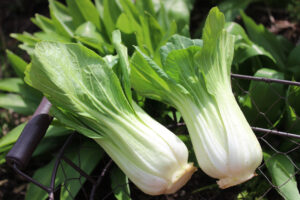How Long Does Vegetable Broth Last | Veggie Broth Recipes
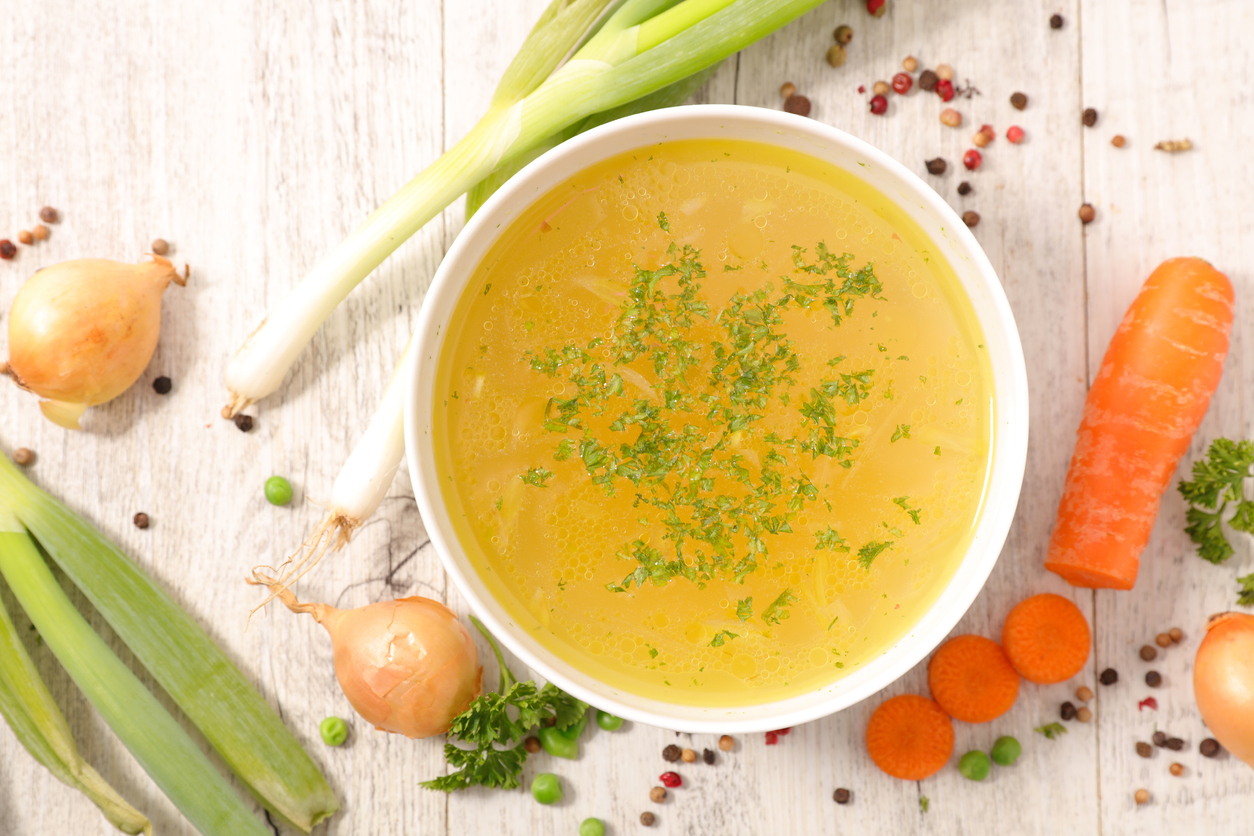
"How long does vegetable broth last?" Understanding the answer to this question is crucial for efficient meal planning. Vegetable broth stands as a versatile cornerstone in countless healthy recipes. Not only does it serve as a savory base for soups and stews, but it also elevates the nutritional profile of pasta dishes and more with its rich blend of vitamins and minerals.
Read on to have many of your vegetable broth questions answered, including an explanation of its shelf life and simple, homemade vegetable broth recipes.
- How long does unopened store-bought veggie broth last?
- How long does opened vegetable broth last?
- Why does vegetable broth spoil if it is only made of vegetables?
- Is vegetable broth healthy?
- Why should I consider making homemade vegetable broth?
- What vegetables can I put in my homemade broth?
- Simple and Customizable Vegetable Broth Recipe
- Can you use cruciferous vegetables in vegetable broth?
- Cruciferous Vegetable Broth Recipe
- Can I made vegetable broth in my slow cooker or Instant Pot?
- Slow Cooker Vegetable Broth Recipe
- Instant Pot Vegetable Broth Recipe
- How long does homemade vegetable broth last?
- How to store homemade veggie broth?
- What is the difference between vegetable broth and vegetable stock?
- Recipes that Include Vegetable Broth from Each Healthy Bite
- More About Proper Food Storage and Shelf Life
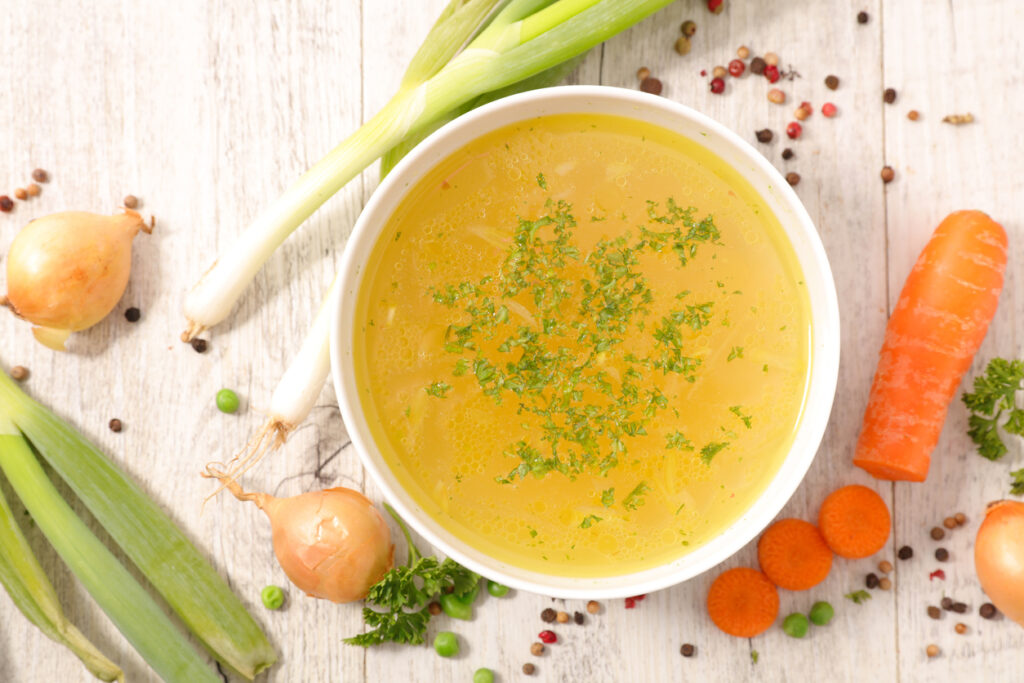
How long does unopened store-bought veggie broth last?
Unopened commercial vegetable broth typically has a long shelf life due to its sealed and preserved condition. On average, commercially produced, unopened vegetable broth in cans or tetra packs can last anywhere from one to three years beyond the expiration date printed on the packaging. However, it's essential to check the specific expiration or best-by date on the product for accuracy.
To maximize the shelf life of unopened vegetable broth, it's advisable to store it in a cool, dry place away from direct sunlight. Proper storage conditions play a crucial role in maintaining the quality and safety of the broth.
Always use your judgment and inspect the broth visually and by smell before using, especially if it has been stored for an extended period. If there are any signs of spoilage, such as an off odor discoloration, or unusual texture, it's a good idea to discard the broth.
How long does opened vegetable broth last?
Once opened, the shelf life of vegetable broth is significantly reduced compared to unopened broth. In general, an opened container of vegetable broth, whether homemade or store-bought, should be refrigerated and consumed within 4 to 5 days for peak quality.
Here are some key points to keep in mind for preserving the best quality and safety of opened vegetable broth:
- Refrigeration: Always store opened vegetable broth in the refrigerator. The cool temperature slows down the growth of bacteria and helps maintain its freshness.
- Airtight Container: Transfer any unused portion of the broth to airtight storage containers before refrigerating. A plastic container or glass containers, such as mason jars, will work well. This minimizes exposure to air and helps preserve the flavor.
- Check for Spoilage: Before using opened store-bought broths, visually inspect it for any signs of spoilage, such as an off smell, unusual color, or mold. If you notice any of these signs, it's best to discard the broth.
- Freezing: If you're unable to use the opened vegetable broth by the sell-by date, consider freezing it. Pour the broth into freezer-safe containers, leaving some space for expansion, and label with the date. Frozen vegetable broth can last for a couple of months or more.
Why does vegetable broth spoil if it is only made of vegetables?
Vegetable broth can spoil despite its seemingly simple ingredients of vegetables and water due to the presence of naturally occurring microorganisms and the potential for contamination during preparation and storage. Here are several reasons why vegetable broth may spoil:
- Natural Microorganisms: Vegetables inherently contain microorganisms, including bacteria, yeast, and molds. Even with proper washing, some microorganisms may remain on the vegetables. When these vegetables are used to make broth, the microorganisms can multiply and contribute to spoilage.
- Contamination during Preparation: The process of preparing vegetable broth involves cutting, chopping, and handling vegetables, which can introduce bacteria from hands, utensils, or surfaces into the broth. If proper hygiene practices are not followed, contamination can occur.
- Storage Conditions: Vegetable broth is susceptible to spoilage if not stored under optimal conditions. Refrigeration slows down the growth of bacteria and other microorganisms, but if the broth is left at room temperature for an extended period, it can become a breeding ground for spoilage microorganisms.
- Air Exposure: Exposure to air can also contribute to spoilage. When vegetable broth is stored in open containers or containers with inadequate seals, airborne microorganisms can enter, accelerating the spoilage process.
- Incomplete Pasteurization or Sterilization: Commercially produced vegetable broth is often pasteurized or sterilized to kill bacteria and extend shelf life. If homemade broth or a product with incomplete processing is not heated sufficiently, some bacteria may survive, leading to spoilage.
- High Water Content: The water content in vegetable broth provides an environment conducive to microbial growth. While the vegetables may contribute to the depth of flavor and nutrients, they also introduce moisture, which can support the proliferation of spoilage microorganisms.
To minimize the risk of spoilage and promote food safety, it's crucial to follow proper hygiene practices during preparation, store vegetable broth in airtight containers in the refrigerator, and consume it within a recommended timeframe. Additionally, commercial vegetable broth often contains preservatives to enhance shelf life and prevent spoilage.
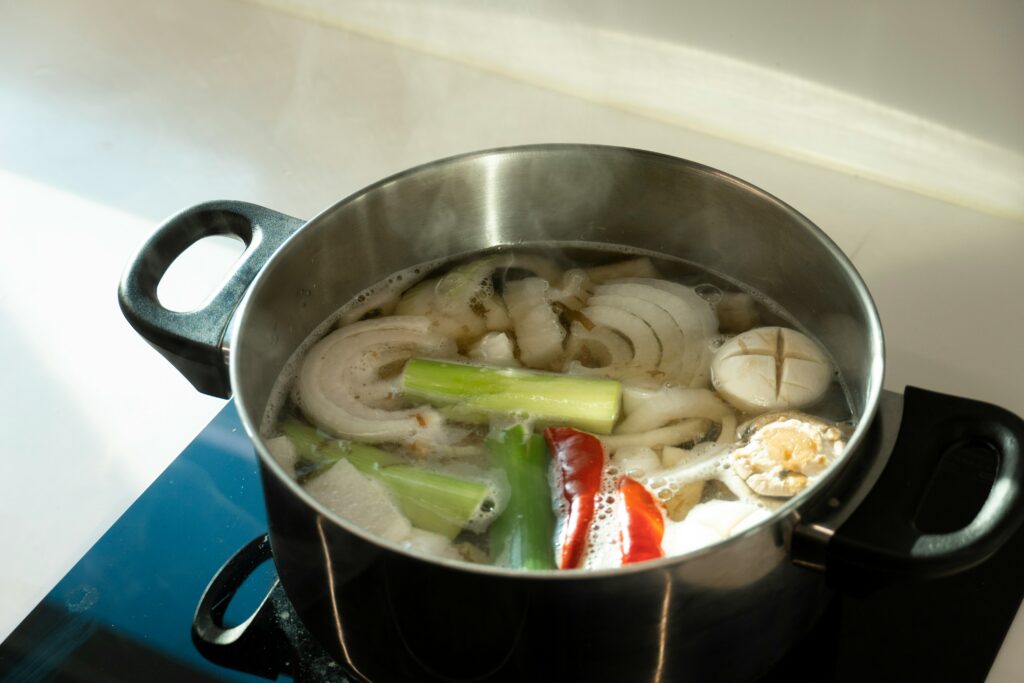
Is vegetable broth healthy?
Vegetable broth is considered a healthy addition to a balanced diet for several reasons:
- Nutrient-Rich: Vegetable broth is made by simmering a variety of vegetables, and during this process, many of the nutrients from the vegetables leach into the broth. This includes vitamins, minerals, and antioxidants that contribute to overall health and well-being.
- Low in Calories: Vegetable broth is typically low in calories, making it a suitable option for those looking to manage their calorie intake. It can be used as a flavorful, low-calorie base for soups and stews.
- Hydration: Broths, including vegetable broth, contribute to overall hydration. Staying well-hydrated is essential for various bodily functions, including digestion, temperature regulation, and nutrient transport.
- Digestive Health: The vegetables used in vegetable broth often contain dietary fiber, which is beneficial for digestive health. While the fiber content in the broth itself may be lower than in whole vegetables, it can still contribute to a healthy digestive system.
- Supports Immune Function: The vitamins and minerals present in vegetable broth, such as vitamin C and antioxidants, play a role in supporting immune function. These nutrients contribute to the body's ability to defend against infections and illnesses.
- Versatility in Cooking: Vegetable broth adds depth of flavor to a variety of dishes without the need for excessive amounts of salt or unhealthy fats. It can be used in place of water in recipes, enhancing the nutritional content of meals.
- Low in Saturated Fat: Vegetable broth is naturally low in saturated fat, making it a heart-healthy option. Excessive intake of saturated fat is associated with an increased risk of heart disease.
It's important to note that the nutritional content of vegetable broth can vary based on the specific vegetables used and whether additional seasonings or salt are added during preparation. Homemade vegetable broth allows for greater control over ingredients and can be tailored to individual preferences and dietary needs. Additionally, individuals with specific health conditions or dietary restrictions should consider any potential allergens or intolerances when consuming vegetable broth.
Why should I consider making homemade vegetable broth?
Making homemade vegetable broth offers several advantages compared to store-bought options:
- Control Over Ingredients:
- Homemade: You have complete control over the ingredients, allowing you to choose organic, fresh, and high-quality vegetables. You can also tailor the broth to suit your taste preferences and dietary restrictions.
- Store-Bought: Commercial broths may contain additives, preservatives, and high levels of sodium. Homemade broth allows you to avoid these additives and create a purer product.
- Reduced Sodium Content:
- Homemade: You can control the amount of salt in homemade broth, making it a healthier option for those watching their sodium intake.
- Store-Bought: Many store-bought broths are high in sodium, which may contribute to health concerns such as high blood pressure.
- Less Waste:
- Homemade: Making broth at home allows you to use vegetable scraps, such as peels and stems, reducing kitchen waste and promoting sustainability.
- Store-Bought: Commercial broths often come in packaging that contributes to environmental waste.
- Richer Flavor:
- Homemade: You can experiment with various vegetables, herbs, and spices, resulting in a richer and more nuanced flavor profile.
- Store-Bought: While convenient, store-bought broths may lack the depth of flavor that comes from using a diverse range of fresh ingredients.
- Customization:
- Homemade: You can tailor homemade broth to match the flavors you desire for specific recipes. For example, you can create a robust broth for hearty stews or a milder one for delicate soups.
- Store-Bought: Commercial broths may have a standardized flavor that may not suit every dish.
- Cost-Effective:
- Homemade: Making broth at home can be cost-effective, especially if you use vegetable scraps that would otherwise be discarded.
- Store-Bought: High-quality store-bought broths can be expensive, and the cost may add up over time.
- Freshness:
- Homemade: You can make broth with fresh, seasonal vegetables, ensuring the freshness and quality of the ingredients.
- Store-Bought: Commercial broths may have a longer shelf life, but the freshness of the ingredients may not be as guaranteed.
While store-bought broth is convenient, making your own allows you to prioritize freshness, quality, and customization while reducing your environmental footprint. Homemade vegetable broth is a versatile kitchen staple that can elevate the flavor of your dishes.
What vegetables can I put in my homemade broth?
Homemade vegetable broth offers a flexible and customizable base for various recipes. Here is a list of fresh ingredients commonly used to make vegetable broth, providing a flavorful and nutrient-rich foundation:
- Onions: Both yellow and white onions add a savory depth of flavor to the broth.
- Carrots: Carrots contribute sweetness and a vibrant orange color to the broth.
- Celery: Celery adds a mild, herbal flavor and helps enhance the overall aroma.
- Garlic: Garlic provides a pungent and aromatic quality, enhancing the broth's taste.
- Leeks: Leeks offer a milder onion flavor and can be used in combination with or as a substitute for onions.
- Mushrooms: Various mushrooms, such as shiitake or white button mushrooms, can add umami richness to the broth. Be sure to include the nutrient-rich mushroom stems
- Tomatoes: Fresh or canned tomatoes provide acidity and depth of flavor. Be mindful of their contribution to the broth's color.
- Parsnips: Parsnips add a subtle sweetness and complexity to the broth.
- Bell Peppers: Both sweet red and green bell peppers contribute sweetness and color.
- Fresh Thyme: Fresh or dried thyme provides a fragrant, earthy element to the broth.
- Bay Leaves: Bay leaves impart a subtle, herbal aroma to the broth.
- Parsley: Fresh parsley adds brightness and a hint of freshness.
- Peppercorns: Whole black or mixed peppercorns bring a mild heat to the broth.
- Salt: A small amount of salt enhances the overall flavor, but it can be adjusted based on individual preferences.
Feel free to experiment with quantities and combinations of these fresh vegetables to tailor the broth to your taste preferences. Additionally, you can add vegetable peels and leftover vegetable scraps like carrot tops and carrot peels, celery leaves, potato peels, corn cobs, the ends of onions or onion skins (onion peels) for minimal waste and extra flavor. It's a versatile and sustainable way to use veggie scraps that might otherwise be turned into food waste.
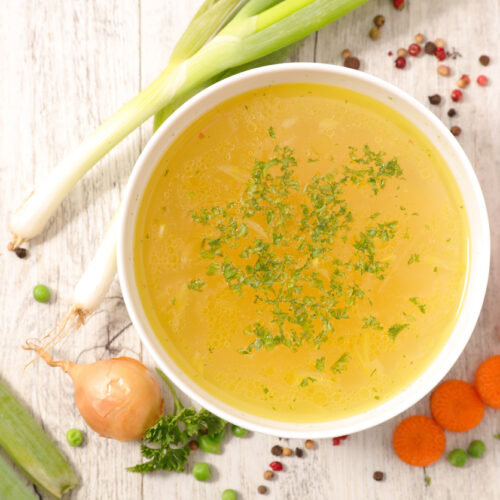
Simple and Customizable Vegetable Broth Recipe
Ingredients
- 1 large onion roughly chopped
- 2 carrots sliced
- 2 celery stalks chopped
- 3 cloves garlic smashed
- 1 parsnip sliced (optional)
- 1 leek chopped (optional)
- 8 cups water
- 1 cup mushrooms sliced
- 1 tomato chopped (or 1 can of diced tomatoes)
- 1 handful fresh parsley
- 2 bay leaves
- 1 teaspoon whole black peppercorns
- Salt to taste
Instructions
- Preparation: Rinse and chop all the vegetables. There's no need to peel them unless you prefer to.
- Sauté Aromatics: In a large pot, sauté the onion, carrots, celery, and garlic over medium heat for about 5 minutes until they start to soften. This step enhances the flavor of the broth.
- Add Remaining Ingredients: Add the parsnip, leek (if using), water, mushrooms, tomato, parsley, bay leaves, and black peppercorns to the pot.
- Bring to a Boil: Increase the heat to high and bring the mixture to a boil.
- Simmer: Once boiling, reduce the heat to low and let the broth simmer uncovered for at least 45 minutes to 1 hour. This allows the flavors to meld.
- Strain: After simmering, strain the broth using a fine-mesh strainer or cheesecloth into a large bowl or another pot. Discard the solid vegetable pieces.
- Season: Taste the broth and add salt as needed. Remember that you can always add more salt later, so start with a smaller amount.
- Cool and Store: Allow the broth to cool before transferring it to containers. Refrigerate or freeze for later use.
Can you use cruciferous vegetables in vegetable broth?
Yes, you can use cruciferous vegetables! Including cruciferous vegetables like broccoli, cauliflower, kale, Brussels sprouts, and cabbage can add depth of flavor and nutritional benefits to your broth. However, it's important to consider a few factors:
- Flavor Intensity: Cruciferous vegetables have a distinct and robust flavor. While this can enhance the complexity of the broth, be mindful of the quantity you add to avoid overpowering the overall taste.
- Bitterness: Some cruciferous vegetables, especially if overcooked, can impart a slightly bitter taste. To avoid this, do not simmer the broth for an extended period, and taste as you go to ensure a balanced flavor.
- Variety: Experiment with different cruciferous vegetables to find the combination that suits your taste preferences. For example, broccoli stems can add a mild sweetness, while kale can contribute earthiness.
- Balancing Flavors: Consider combining cruciferous vegetables with other aromatic vegetables like onions, carrots, and celery to balance the flavors and create a well-rounded broth.
Cruciferous Vegetable Broth Recipe
Ingredients
- 1 onion, roughly chopped
- 2 carrots, sliced
- 2 celery stalks, chopped
- 2 cloves garlic, smashed
- 1 cup broccoli florets
- 1 cup cauliflower florets
- 1 cup kale, chopped
- 1 bay leaf
- 1 teaspoon whole black peppercorns
- Salt, to taste
- 8 cups water
Instructions:
- In a large pot, combine all the ingredients.
- Bring the mixture to a boil and then reduce the heat to simmer.
- Simmer for about 30-45 minutes, tasting occasionally and adjusting seasoning as needed.
- Strain the broth with a fine mesh strainer, discarding the solids.
- Use the cruciferous vegetable broth in your favorite recipes or as a base for soup recipes.
Remember that the key to a well-balanced broth is experimentation and adjusting ingredients to suit your preferences.
Can I made vegetable broth in my slow cooker or Instant Pot?
Absolutely! Both a slow cooker (Crock-Pot) and an Instant Pot can be put to good use for making the most delicious vegetable broth. Here's a brief guide for each:
Slow Cooker Vegetable Broth Recipe
Ingredients
- Various vegetables (onions, carrots, celery, leeks, mushrooms, etc.)
- Garlic cloves
- Fresh herbs (thyme, parsley, bay leaves)
- Peppercorns
- Salt, to taste
- Water
Instructions
- Chop the vegetables into large chunks.
- Place the vegetables, garlic, herbs, peppercorns, and salt in the slow cooker.
- Add enough water to cover the vegetables.
- Cook on low for 6-8 hours or on high for 3-4 hours.
- Strain the broth, discarding the solids.
- Use the vegetable broth as needed or store for later use.
Instant Pot Vegetable Broth Recipe
Instant Pot Vegetable Broth Ingredients
- Various vegetables (onions, carrots, celery, leeks, mushrooms, etc.)
- Garlic cloves
- Fresh herbs (thyme, parsley, bay leaves)
- Peppercorns
- Salt, to taste
- Water
Instant Pot Vegetable Broth Instructions
- Chop the vegetables into large chunks.
- Place the vegetables, garlic, herbs, peppercorns, and salt in the Instant Pot.
- Add enough water to cover the vegetables, ensuring you do not exceed the maximum fill line.
- Set the Instant Pot to the "Soup" setting or manual high pressure for 30 minutes.
- Allow natural pressure release or perform a quick release, depending on your preference.
- Strain the broth, discarding the solids.
- Use the vegetable broth immediately or store it for later use
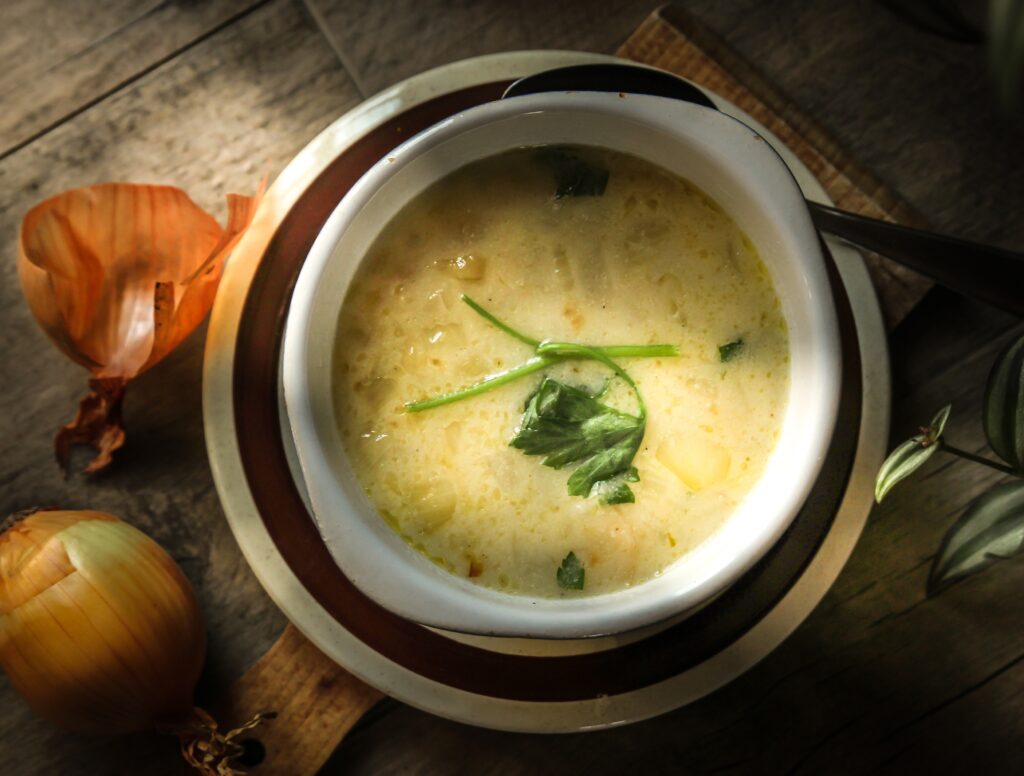
How long does homemade vegetable broth last?
The shelf life of homemade vegetable stock or broth depends on how it is stored. Here are some general guidelines:
- Refrigeration:
- If stored in the refrigerator, homemade vegetable broth is typically good for about 4 to 5 days.
- To maximize freshness, use airtight containers and ensure the broth cools to room temperature before refrigerating.
- Freezing:
- If frozen, homemade vegetable broth can last for several months. The exact duration can vary based on the quality of freezing and the type of container used.
- For the best results, use freezer-safe containers, leaving some space for expansion as the broth freezes.
- Quality Check:
- Before using stored broth, visually inspect it for any signs of spoilage, such as off smells, unusual colors, or mold.
- If the broth looks or smells suspicious, it's best to discard it.
Remember to label containers with the date of preparation to track freshness. Additionally, proper sanitation and hygiene practices during preparation, storage, and handling can help extend the shelf life of homemade vegetable broth.
Always use your judgment, and when in doubt, err on the side of caution to ensure food safety.
How to store homemade veggie broth?
Storing homemade broth properly is crucial to maintain its quality and safety. Here's how to store homemade broth:
- Cooling:
- Allow the homemade broth to cool to room temperature after straining.
- For faster cooling, you can place the pot in an ice bath or divide the broth into smaller containers.
- Refrigeration:
- If you plan to use the broth within a few days, store it in airtight containers in the refrigerator.
- Use containers with tight-sealing lids to prevent odors from the fridge from affecting the broth's flavor.
- Homemade vegetable broth stored in the refrigerator is typically good for about 4 to 5 days.
- Freezing:
- For longer storage, consider freezing the broth.
- Use freezer-safe containers or portion the broth into ice cube trays for convenient small servings. A freezer bag also works well.
- Leave some space in the containers to allow for expansion as the broth freezes.
- Frozen vegetable broth can last for several months.
- Labeling:
- Clearly label containers with the date of preparation to keep track of freshness.
- Indicate whether salt has been added or if it's unsalted, especially if you plan to use it in specific recipes.
- Thawing:
- When ready to use frozen broth, thaw it in the refrigerator overnight or use the defrost function on the microwave.
- You can also place the frozen container in a bowl of cold water for quicker thawing.
- Reheating:
- Reheat the broth on the stove over medium heat, stirring occasionally. Avoid high temperature to prevent boiling.
- Microwave reheating is also an option, but be sure to use microwave-safe containers.
- Quality Check:
- Before using stored broth, visually inspect it for any signs of spoilage, such as off smells, unusual colors, or mold.
- If the broth looks or smells suspicious, it's best to discard it.
Remember that proper storage practices are essential to ensure the safety and flavor of your homemade broth. Regularly clean and sanitize containers and utensils used for storing and reheating to prevent contamination.
What is the difference between vegetable broth and vegetable stock?
While the terms "vegetable stock" and "vegetable broth" are often used interchangeably, there are subtle differences between the two, and the distinction can vary based on culinary traditions and personal interpretations. Here are the general differences:
- Ingredients:
- Vegetable Stock: Typically made with a higher proportion of vegetables, including aromatic vegetables like onions, carrots, and celery, along with herbs and spices. It's intended to be a neutral base for various recipes.
- Vegetable Broth: Usually contains a greater variety of vegetables and seasonings, aiming to be a more finished and flavorful product on its own.
- Flavor Intensity:
- Vegetable Stock: Tends to have a milder flavor, allowing it to blend seamlessly into various dishes without overpowering the final taste.
- Vegetable Broth: Often has a more pronounced flavor due to the variety of vegetables and seasonings used, making it suitable as a standalone soup or as a flavorful addition to recipes.
- Seasoning:
- Vegetable Stock: Minimally seasoned, if at all, to provide a neutral base for recipes where specific seasonings are desired.
- Vegetable Broth: May include herbs, spices, and additional seasonings to create a well-seasoned and ready-to-use product.
- Intended Use:
- Vegetable Stock: Primarily used as a base for sauces, gravies, and other dishes where a subtle vegetable flavor is desired.
- Vegetable Broth: Often used as a standalone soup, sipped on its own or enhanced with additional ingredients. It's also used in recipes where a more developed vegetable flavor is desired.
- Customization:
- Vegetable Stock: Chefs often prefer stock when they want more control over the final flavor of a dish and plan to add specific seasonings according to the recipe.
- Vegetable Broth: Offers a convenient and flavorful option for those who want a ready-to-use product without additional adjustments.
It's essential to note that these distinctions are not rigid, and the terms may be used interchangeably in many recipes.
Recipes that Include Vegetable Broth from Each Healthy Bite




More About Proper Food Storage and Shelf Life
